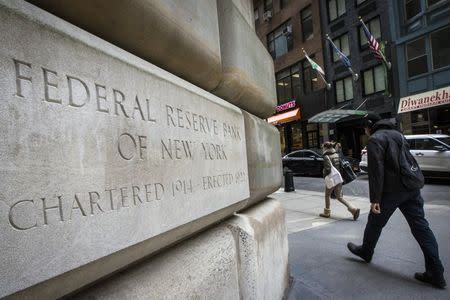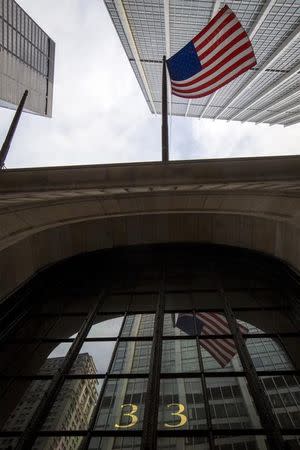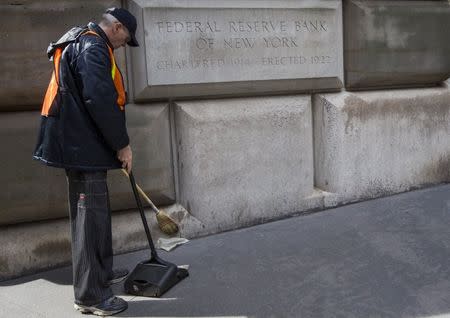Fed market gurus prep rate hike amid last-minute anxieties
By Jonathan Spicer NEW YORK (Reuters) - The New York Federal Reserve officials tasked with prying interest rates off the floor have been meeting with bankers and traders to plot how best to do it, amid deep uncertainty over how much control they will really have over short-term lending markets. With the U.S. central bank expected to raise rates later this year, Simon Potter and his team of market technicians have the tricky job of implementing higher rates using some new and lightly tested tools as well as some that may not work as well as in the past. They'll be operating under intense global scrutiny that's centered on the prospects for the world’s biggest economy. Even while testing new methods meant to sweep up trillions of dollars of reserves from financial markets, Potter's team is preparing for volatility and to make on-the-fly adjustments when the time comes, according to interviews with Fed officials and market participants. The trouble is that the federal funds market, the intra-bank trading pool traditionally used by the Fed to meet its policy goals, has shrunk to about a quarter of its pre-crisis size after more than six years of unprecedented monetary stimulus. "There is a lot more uncertainty in the mechanical features of the outlook than people admit to," said Joseph Abate, a money-market strategist at Barclays Capital. The Fed wants to avoid a scenario in which yields don't rise enough after it lifts the fed funds rate because banks, flush with $2.5 trillion of reserves parked at the central bank, don't need short-term funding. The central bank also risks being drawn so deeply into money markets that it destabilizes things. That's why the New York Fed, already under political pressure due to regulatory missteps, is taking every precaution it can to protect its credibility and that of the central bank. It wants to make sure that when the central bank decrees higher rates, yields will actually rise. To combat anxieties on Wall Street and in Washington, Potter and his deputies have been hosting regular lunches with market participants to ask and field questions about what sort of market tinkering might be needed or avoided to get it right, and how banks and funds will react. He has also met with officials at the European Central Bank and other global counterparts to outline the U.S. plan to tighten when most of them are easing. "The New York Fed is thinking about these things a lot, and so are we," said Barclays' Abate, who attended a recent lunch with Potter. A few blocks off Wall Street, the New York Fed has long handled the central bank's market operations. This time, it will have to rely on unfamiliar counterparties like money market mutual funds, and new tools such as an overnight reverse repurchase facility, or ON RRP, to vacuum up as many reserves from the system as necessary to achieve "liftoff." GLOBAL SPOTLIGHT The Fed has put on a brave face that it can smoothly lift rates from the current range of zero to 0.25 percent. Fed Chair Janet Yellen told a congressional panel last month that she is confident about maintaining "reasonable control" of short-term yields. The question is whether the fed funds rate will slip below the "floor" created by ON RRP, likely to be set at 0.25 percent after liftoff. The "ceiling" will be a rate the Fed pays banks on excess reserves, called IOER, likely to be 0.5 percent. Traders and policymakers alike expect volatility. Many also expect the fed funds rate to slip toward and even below the floor at the end of quarters and months, when money funds will look to the repo facility to dump cash in exchange for Treasuries, pushing rates lower. If this slippage happens over and over, the New York Fed is expected to increase its ON RRP program beyond the current overall cap of $300 billion, according to policymakers and traders. It may even make the facility unlimited for a period, and turn to another new tool, term reverse repos, to help drain reserves. This would be when the central bank risks destabilizing the $2.7-trillion money fund market by encouraging a "disruptive flight-to-quality," as Fed Vice Chair Stanley Fischer warned this week. "They'll do as much as they absolutely have to, and they may get there through trial and error," said Louis Crandall, chief economist at Wrightson ICAP in Jersey City, New Jersey. "Managing the communications at the top level will be critical because there is simply no precedent for this liftoff." For the last several months, Potter and his top lieutenants Lorie Logan and Joshua Frost have been inviting a handful of traders and bankers at a time to lunches at the New York Fed. Potter, who co-headed the New York Fed's research wing before taking over its market operations in 2012, uses the meetings to ask how best to avoid fed funds slippage, sources said. He's also asked whether aggressive use of term repos would disrupt usage of ON RRP. Potter will address the Money Marketeers bond traders group on April 15, a speech that quickly sold out. He and others in New York Fed's market operations unit declined interview requests. Logan and Frost are veterans of the markets group who, unlike Potter, were there in the depths of the 2008 financial crisis when U.S. rates were last adjusted. Several others in the group have since left, leaving some new faces to begin raising rates. POLITICAL PRESSURE Potter and his boss, New York Fed President William Dudley, have publicly expressed confidence they have the tools to keep things under control. Any mishandling could put Dudley back into the political cross-hairs after lawmakers called him to account last year for lax oversight of Wall Street banks. Senator Jack Reed is pushing legislation that would make Dudley's position politically-appointed instead of one chosen by the New York Fed's board. Dudley, who also declined an interview request, has acknowledged that the once-reliable linkage between the fed funds rate and broader financial conditions has grown unstable. Minutes from Fed meetings in Washington suggest anxiety over the mechanics of liftoff, with policymakers in January considering tweaks to ON RRP but also sounding more willing to use it aggressively. The overnight repo facility has been tested for 18 months running and is open to 164 money funds, banks, and government sponsored enterprises like Fannie Mae and Freddie Mac . Unlike Wall Street's primary dealers that have long served as the New York Fed's counterparties, the central bank does not directly regulate money markets. That's causing some concern. In her report to Congress in March, Yellen highlighted that money markets, which are key to the planned liftoff, remain vulnerable to investor runs. Another risk to liftoff is a possible overseas crisis that brings a rush of capital into safe U.S. assets like Treasuries, which would depress yields just as the Fed is pushing the other way. Charles Plosser, who stepped down as president of the Philadelphia Fed earlier this month, told Reuters before retiring that there was internal disagreement over how much rates volatility the central bank should tolerate when it finally starts to tighten policy. "At the end of the day," he said, "we won't know for sure until we start it." (Additional reporting by Michael Flaherty in Washington, Ann Saphir in San Francisco, and Richard Leong in New York. Editing by Dan Burns and John Pickering)





